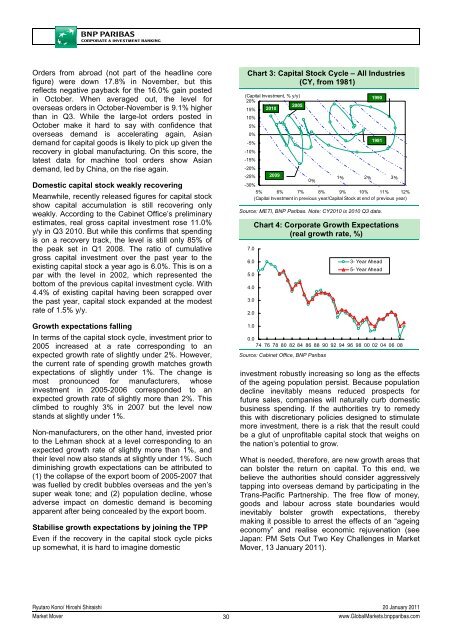Market Economics | Interest Rate Strategy - BNP PARIBAS ...
Market Economics | Interest Rate Strategy - BNP PARIBAS ...
Market Economics | Interest Rate Strategy - BNP PARIBAS ...
Create successful ePaper yourself
Turn your PDF publications into a flip-book with our unique Google optimized e-Paper software.
Orders from abroad (not part of the headline core<br />
figure) were down 17.8% in November, but this<br />
reflects negative payback for the 16.0% gain posted<br />
in October. When averaged out, the level for<br />
overseas orders in October-November is 9.1% higher<br />
than in Q3. While the large-lot orders posted in<br />
October make it hard to say with confidence that<br />
overseas demand is accelerating again, Asian<br />
demand for capital goods is likely to pick up given the<br />
recovery in global manufacturing. On this score, the<br />
latest data for machine tool orders show Asian<br />
demand, led by China, on the rise again.<br />
Domestic capital stock weakly recovering<br />
Meanwhile, recently released figures for capital stock<br />
show capital accumulation is still recovering only<br />
weakly. According to the Cabinet Office’s preliminary<br />
estimates, real gross capital investment rose 11.0%<br />
y/y in Q3 2010. But while this confirms that spending<br />
is on a recovery track, the level is still only 85% of<br />
the peak set in Q1 2008. The ratio of cumulative<br />
gross capital investment over the past year to the<br />
existing capital stock a year ago is 6.0%. This is on a<br />
par with the level in 2002, which represented the<br />
bottom of the previous capital investment cycle. With<br />
4.4% of existing capital having been scrapped over<br />
the past year, capital stock expanded at the modest<br />
rate of 1.5% y/y.<br />
Growth expectations falling<br />
In terms of the capital stock cycle, investment prior to<br />
2005 increased at a rate corresponding to an<br />
expected growth rate of slightly under 2%. However,<br />
the current rate of spending growth matches growth<br />
expectations of slightly under 1%. The change is<br />
most pronounced for manufacturers, whose<br />
investment in 2005-2006 corresponded to an<br />
expected growth rate of slightly more than 2%. This<br />
climbed to roughly 3% in 2007 but the level now<br />
stands at slightly under 1%.<br />
Non-manufacturers, on the other hand, invested prior<br />
to the Lehman shock at a level corresponding to an<br />
expected growth rate of slightly more than 1%, and<br />
their level now also stands at slightly under 1%. Such<br />
diminishing growth expectations can be attributed to<br />
(1) the collapse of the export boom of 2005-2007 that<br />
was fuelled by credit bubbles overseas and the yen’s<br />
super weak tone; and (2) population decline, whose<br />
adverse impact on domestic demand is becoming<br />
apparent after being concealed by the export boom.<br />
Stabilise growth expectations by joining the TPP<br />
Even if the recovery in the capital stock cycle picks<br />
up somewhat, it is hard to imagine domestic<br />
Chart 3: Capital Stock Cycle – All Industries<br />
(CY, from 1981)<br />
(Capital Investment, % y/y)<br />
20%<br />
1990<br />
15% 2010<br />
2005<br />
10%<br />
5%<br />
0%<br />
-5%<br />
1981<br />
-10%<br />
-15%<br />
-20%<br />
-25% 2009<br />
0<br />
1 2 3<br />
-30%<br />
5% 6% 7% 8% 9% 10% 11% 12%<br />
(Capital Investment in previous year/Capital Stock at end of previous year)<br />
Source: METI, <strong>BNP</strong> Paribas. Note: CY2010 is 2010 Q3 data.<br />
7.0<br />
6.0<br />
5.0<br />
4.0<br />
3.0<br />
2.0<br />
1.0<br />
Chart 4: Corporate Growth Expectations<br />
(real growth rate, %)<br />
0.0<br />
74 76 78 80 82 84 86 88 90 92 94 96 98 00 02 04 06 08<br />
Source: Cabinet Office, <strong>BNP</strong> Paribas<br />
3- Year Ahead<br />
5- Year Ahead<br />
investment robustly increasing so long as the effects<br />
of the ageing population persist. Because population<br />
decline inevitably means reduced prospects for<br />
future sales, companies will naturally curb domestic<br />
business spending. If the authorities try to remedy<br />
this with discretionary policies designed to stimulate<br />
more investment, there is a risk that the result could<br />
be a glut of unprofitable capital stock that weighs on<br />
the nation’s potential to grow.<br />
What is needed, therefore, are new growth areas that<br />
can bolster the return on capital. To this end, we<br />
believe the authorities should consider aggressively<br />
tapping into overseas demand by participating in the<br />
Trans-Pacific Partnership. The free flow of money,<br />
goods and labour across state boundaries would<br />
inevitably bolster growth expectations, thereby<br />
making it possible to arrest the effects of an “ageing<br />
economy” and realise economic rejuvenation (see<br />
Japan: PM Sets Out Two Key Challenges in <strong>Market</strong><br />
Mover, 13 January 2011).<br />
Ryutaro Kono/ Hiroshi Shiraishi 20 January 2011<br />
<strong>Market</strong> Mover<br />
30<br />
www.Global<strong>Market</strong>s.bnpparibas.com

















